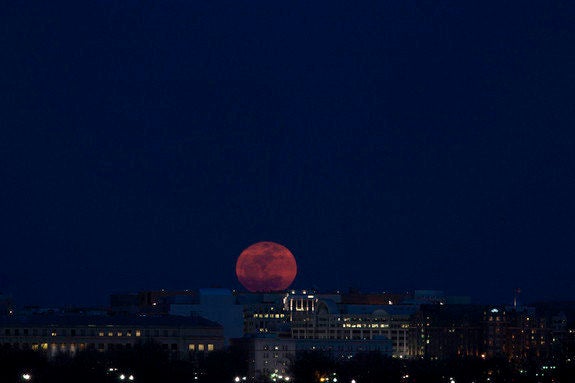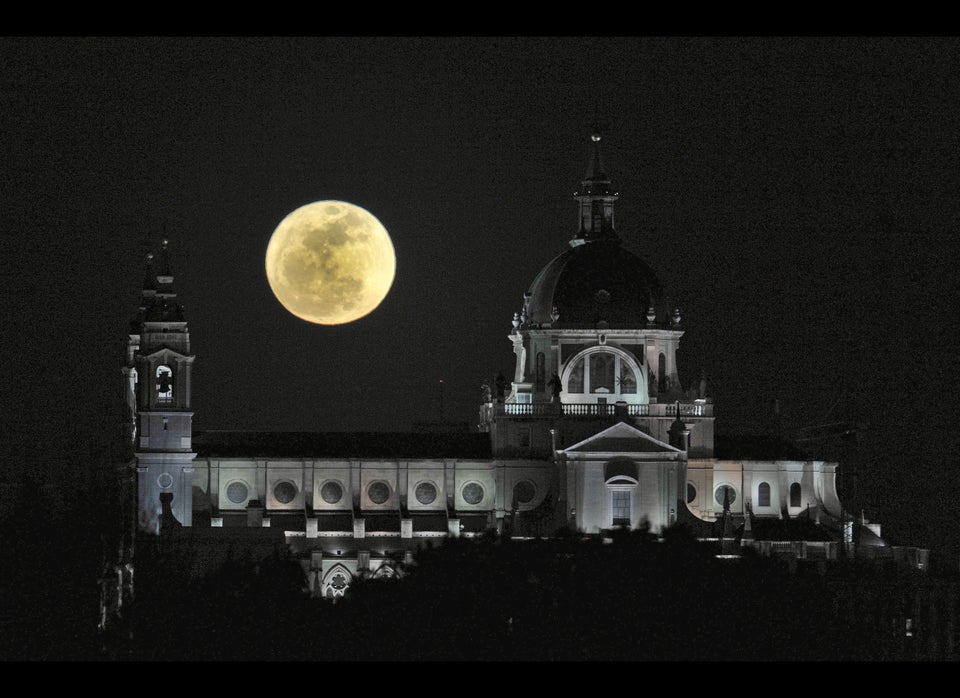
Be sure to tweet us your supermoon pics at @HuffPostScience, hashtag #supermoon! We'll be collecting user submissions from all over, and yours may be featured.
By: Tariq Malik
Published: 05/03/2012 06:37 PM EDT on SPACE.com
The month of May looks to be a promising one for skywatchers around the world, with the largest full moon of the year — a so-called "supermoon" — kicking things off this weekend. But the moon is just one of several tantalizing sky events this month, which include a meteor shower from Halley's comet and the first solar eclipse of the year.
The skywatching action starts with a celestial double-feature. On Saturday and Sunday (May 5- 6) a "supermoon" of 2012 and the Eta Aquarid meteor shower will both hit their peak.
While the bright full moon could interfere with the Eta Aquarid meteor display, some of the shower's brightest fireballs should still be visible late Saturday and early Sunday, NASA scientists say.
Then, on May 20, the moon will pass in front of the sun but not completely block it, creating what scientists call an annular solar eclipse. Parts of the eclipse will be visible from much of North America, though the western U.S. states are in prime position for the best viewing experiences, according to SPACE.com skywatching columnist Geoff Gaherty.
Here's a look at some of the month's most promising night sky observing events and the solar eclipse:
Supermoon rising
"Supermoon" is the nickname for a full moon that coincides with the moon's arrival at perigee — the point in its orbit that brings it closest to Earth for the month. Perigees occur because the moon's orbit around Earth is not a perfect circle. Instead, it's an ellipse in which the nearest point to Earth is about 31,000miles (50,000 kilometers) closer than the moon's farthest point (called apogee).
When the moon is in its full phase and at perigee, it can appear much brighter and slightly larger than the average full moon. Scientists call this event a "perigee moon." [Amazing Supermoon Photos from 2011]
That's what will occur this weekend during the full moon of May on Saturday, May 5, at 11:35 p.m. EDT (0335 Sunday GMT). To the casual observer, the moon also can appear full one day before and one day after the exact moment it is at its fullest.
On Saturday, the moon will be 221,802 miles (356,955 kilometers) from Earth and should appear up to 14 percent bigger and 30 percent brighter than the typical full moon, according to NASA. The average Earth-moon distance is about 230,000 miles (384,400 km).
While a full moon at perigee can create higher tides than normal, have no fear. The supermoon poses no threat to Earth, scientists say.
Meteors from Halley's comet
At the same time as the supermoon, the annual Eta Aquarid meteor shower is expected to hit its peak, though the bright moonlight is likely to wash out much of the "shooting star" display.
The Eta Aquarids occur between late April and early May when the Earth passes through a stream of dusty debris left behind by the famed Halley's comet during its 76-year trek through our solar system. The meteor shower is one of two created by comet Halley. (The Orionid meteor display in October is the other.)
This year the Eta Aquarids began on April 19 and will run through May 28, though the meteor shower will be at its best during the overnight hours between Saturday and Sunday. Since this coincides with the bright full moon, only the brightest fireballs will be visible. NASA scientists predict between 40 and 60 meteors will be seen per hour.
"NASA fireball cameras have already detected several bright Eta Aquarid meteors this year, so the odds are pretty good that a bit of Halley's comet can be seen over the next few days," NASA scientists wrote in their skywatching alert. "Ideal viewing conditions are clear skies away from city lights, especially just before dawn."
The best way to try to observe the meteor shower is to lie flat on your back and get as much of the sky in your field of view as possible, according to NASA's guide. The space agency will also offer a live webcast of the display from its all-sky meteor camera network on Saturday night here: http://www.nasa.gov/topics/solarsystem/features/watchtheskies/aquarids_2012.html
First solar eclipse of 2012
If the supermoon and meteor shower leave you wanting more skywatching delights, then mark your calendars, because May's celestial display isn't over yet.
On May 20 the moon will cross in front of the sun as seen from Earth but won't completely block the star. What scientists call an annular solar eclipse will be visible along a narrow track that stretches from East Asia (where it will be May 21) across the Pacific Ocean before crossing parts of the western United States. [Video: May 2012 Solar Eclipse Explained]
"A unique annular solar eclipse occurs on May 20 for lucky observers in a path from Eureka, California, to Lubbock, Texas," astronomer Nancy Neal Jones said in a NASA video. "The rest of the United States will see a partial solar eclipse."
When the moon is in its new phase and aligns perfectly with the sun, the effect is a total eclipse. At other times, only a partial solar eclipse is visible. Because the plane of the moon's orbit is slightly different from the plane of Earth's orbit around the sun, there is not a total solar eclipse every month.
An annular solar eclipse occurs when the moon is in its new phase but is too far from Earth to completely block the sun. Instead, it leaves a ring (or annulus) of the sun.
WARNING: Never look directly at the sun through binoculars or a telescope, or with your unaided eye. Severe eye damage can result. Only special solar filters should be used for safe sun viewing.
If you snap an amazing photo of the supermoon of May, Eta Aquarid meteor shower or May 20 solar eclipse and would like to share it with
In addition to the events above, there are still plenty of planets to view at night in May. Venus and Mercury will shine together on May 31, with Mars and Saturn visible at night all month long, Jones said.
SPACE.com for a story or gallery, send photos and comments to managing editor Tariq Malik at: tmalik@space.com.
You can follow SPACE.com Managing Editor Tariq Malik on Twitter @tariqjmalik. Follow SPACE.com for the latest in space science and exploration news on Twitter @Spacedotcom and on Facebook.
